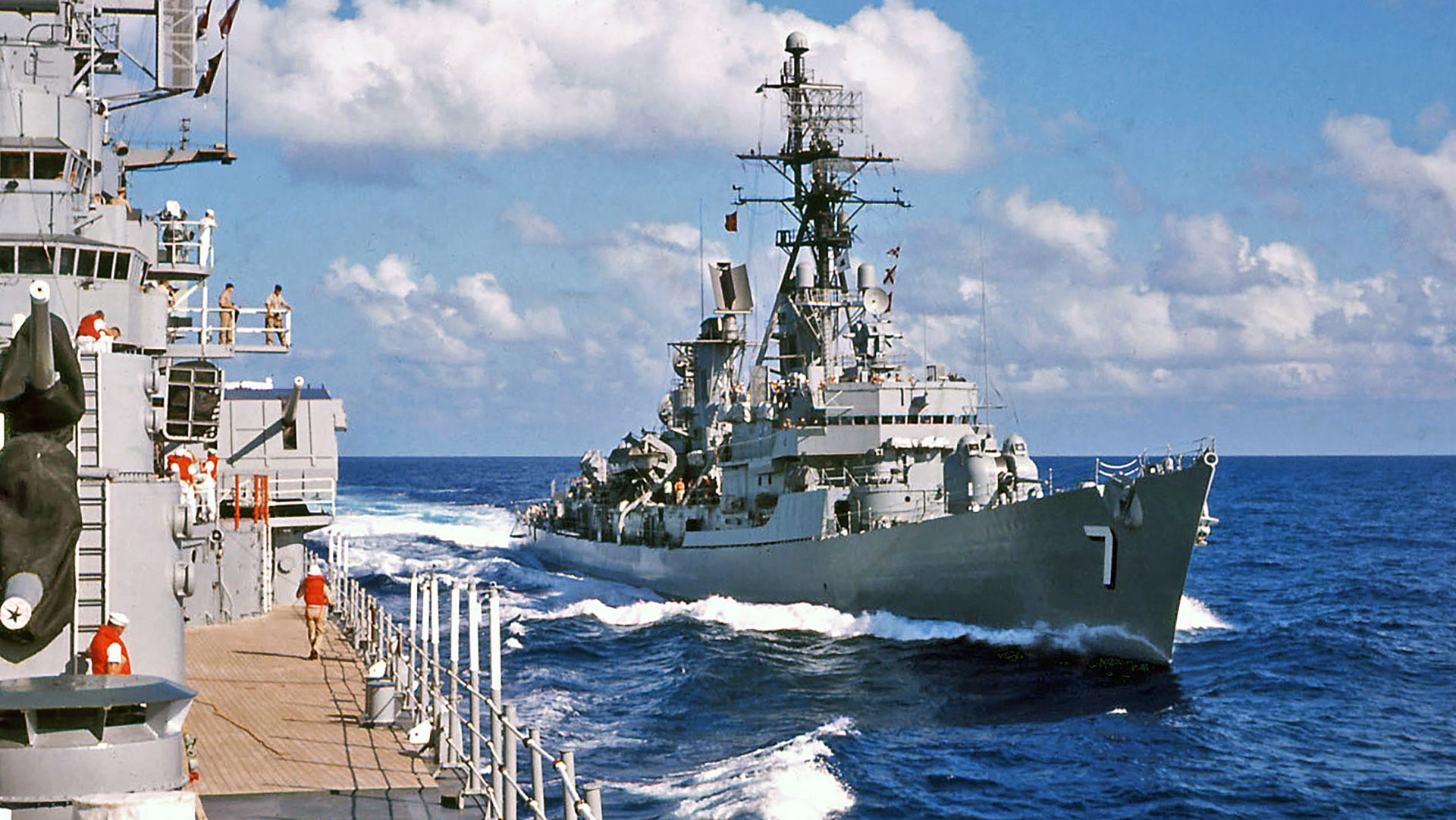In this the second and final part of our “Making Steam” series about the incredible experiences and career insights of US Navy Chief Engineer David Taylor—make sure to read the first part here—we talk memorable adventures and tense close calls on the high seas and what makes a good commanding officer. We also delve into some of the Navy’s most pressing and controversial issues. These include a mix of the service’s top procurement programs—some of which Taylor worked on directly—such as the electromagnetic aircraft launch systems (EMALS) and the DDG-1000 stealth destroyer—during his tenure as a civilian official at Philadelphia Naval Shipyard.
From near friendly fire incidents, to horrendous storms, to how to fix the Navy’s core problems, to the questionable need for Littoral Combat Ships, we cover it all. And just as you probably imagine any salty Navy Chief Engineer should be, Taylor’s commentary is blunt, bold and unafraid.
Trepidation and tension on the high seas
USS David R. Ray, Late 1979, Indian Ocean:
The first few months in the Indian Ocean were hectic times. There were two battle groups there, the Midway’s and the Kitty Hawk’s, to which we were attached. We were there (I believe) to get the Iranians to attack us so that we could introduce them to the potentialities inherent in naval aviation.
We were vectoring fighters to visually identify every aircraft that came anywhere close to the airspace above us. One such intercept was of a large, slow patrol craft heading westward from Karachi along the coast. As the pilot saw the F-4s from Midway approaching him, we heard him exclaim over the Military Air Distress frequency, in a very British accent, “don’t shoot! Don’t shoot! I am Pakistani” He must not have trusted his Identification Friend of Fore (IFF) system that much.
During this period of operations I held the Tactical Action Officer watch. The Tactical Action Officer (TAO) is a position that recognizes that crews may not have time to wake and brief the CO before a Soviet SSN-7 missile flies up your stern, so, after a rigorous school and shipboard qualification, limited weapons release authority was granted to the TAO without the CO’s permission.
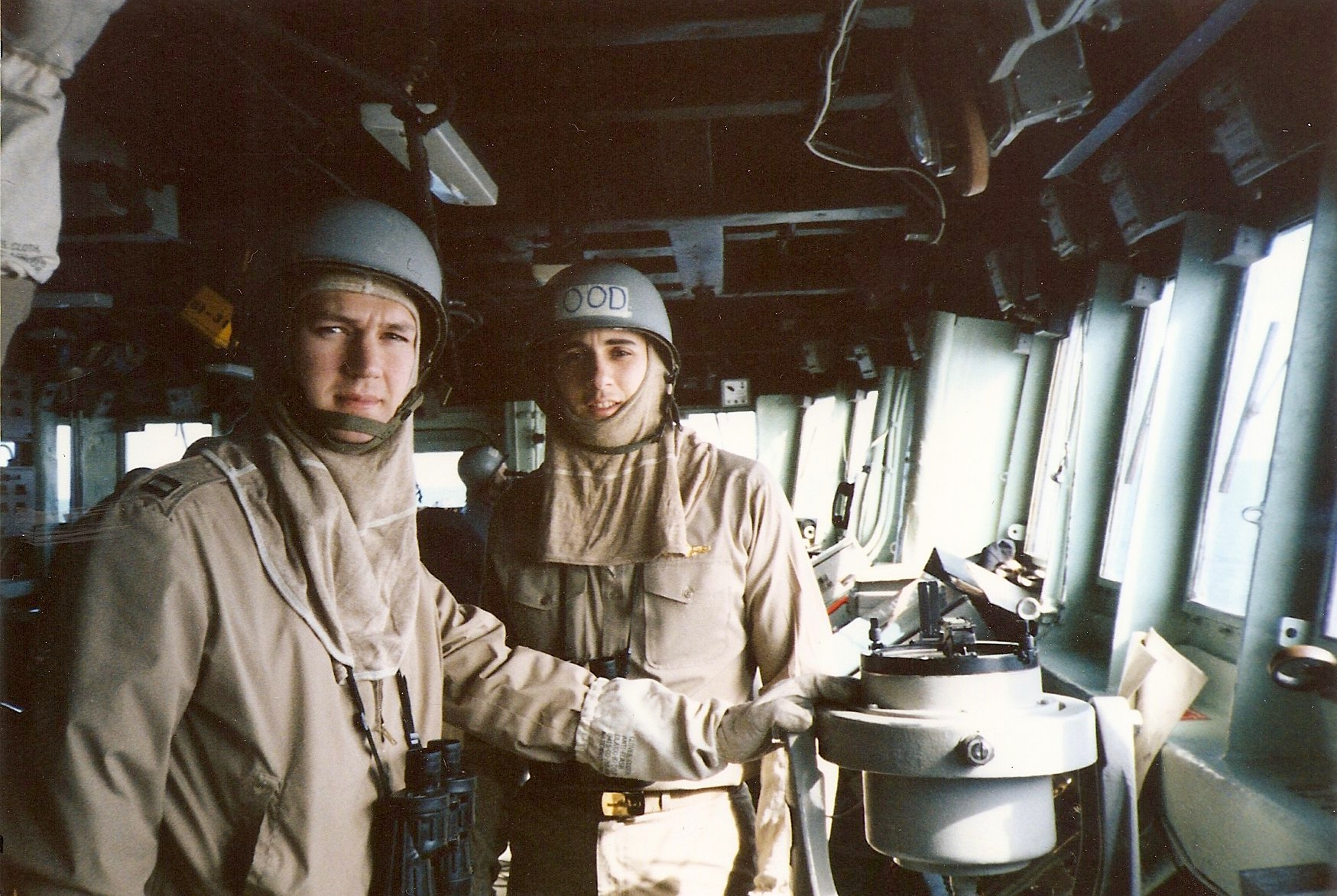
A pair of F-14s were vectored out to identify an aircraft flying from the Arabian mainland, heading directly over us to the Kitty Hawk. One of the pilots called a “tally ho!” and identified the plane as a camouflaged F-4. The correlation circuitry in my forebrain went into overdrive. Midway has F-4s. There are the F-4s we gave the Iranians at Bandar Abbas. Midway’s are grey. The Iranians are… maybe camouflaged?
I hit the General Quarters alarm. I had never seen us get to battle stations quicker. It was the real thing.
Now, the Spruance class destroyer was not, in anyone’s imagination, an anti-air warfare (AAW) platform. We had a pretty good gun, with a good fire control system and Sea Sparrow missiles, good only for targets coming right at you. And this one was.
In AAW, because of the high speed nature of planes and missiles, a philosophy of “command by negation” was frequently invoked. That meant, if you had a shot at a hostile aircraft, you did not wait for direction or permission to shoot. You merely announced over the AAW net that you were going to shoot and with what weapon. If Alfa Whiskey, the AAW commander, did not tell you to hold fire, you shot.
The bogie continued down our throat. The Captain had just made it to CIC and I had picked up the radio mic and had drawn breath to say “taking vampire delta with guns and missiles” when our fighter jock came back over the control circuit and said, “wait, wait, it’s an Omani Jaguar!”
I don’t know when I had a bigger pucker factor, just before I almost released weapons or later when we were told that the plane was piloted by a Royal Air Force major, seconded to the Sultan of Oman, flying the nephew of said Sultan out to look at the “big ships.”
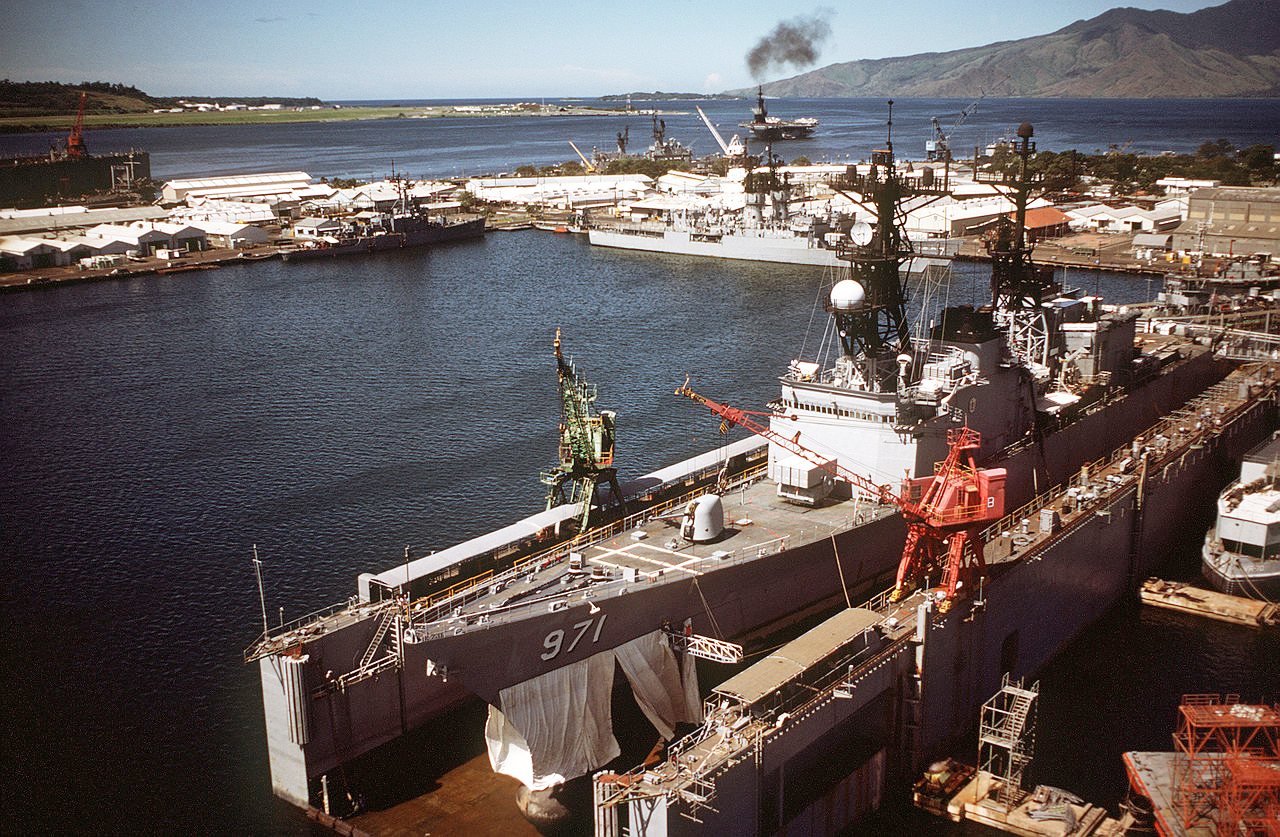
USS David R. Ray, September 1979, somewhere northwest of of Midway Island in the Pacific:
We were caught in a typhoon that blew up out of nowhere. My roommate and I were the only Deck Officers physically capable of standing a watch. I slept in Combat Information Center while he had the deck and vice versa. The seas were so high that the entire forecastle up to the break would disappear into an oncoming wave and then lift clear out of the water exposing our rather large sonar dome as the wave passed down the length of the ship.
Remember that the Spruance class was the size of a WWII cruiser. During the storm, as Officer On Duty, I was amidships on the bridge, hanging desperately on to the cable that was strung from port to starboard especially for that purpose. An extremely heavy roll to port caused me to lose my right hand grip, spinning me around with my left hand as the pivot point until I was facing aft. As the roll eased, my eye caught the inclinometer mounted on the aft bulkhead. It showed a 50 degree roll, meaning that we had rolled beyond that.
Makes you appreciate naval architects!
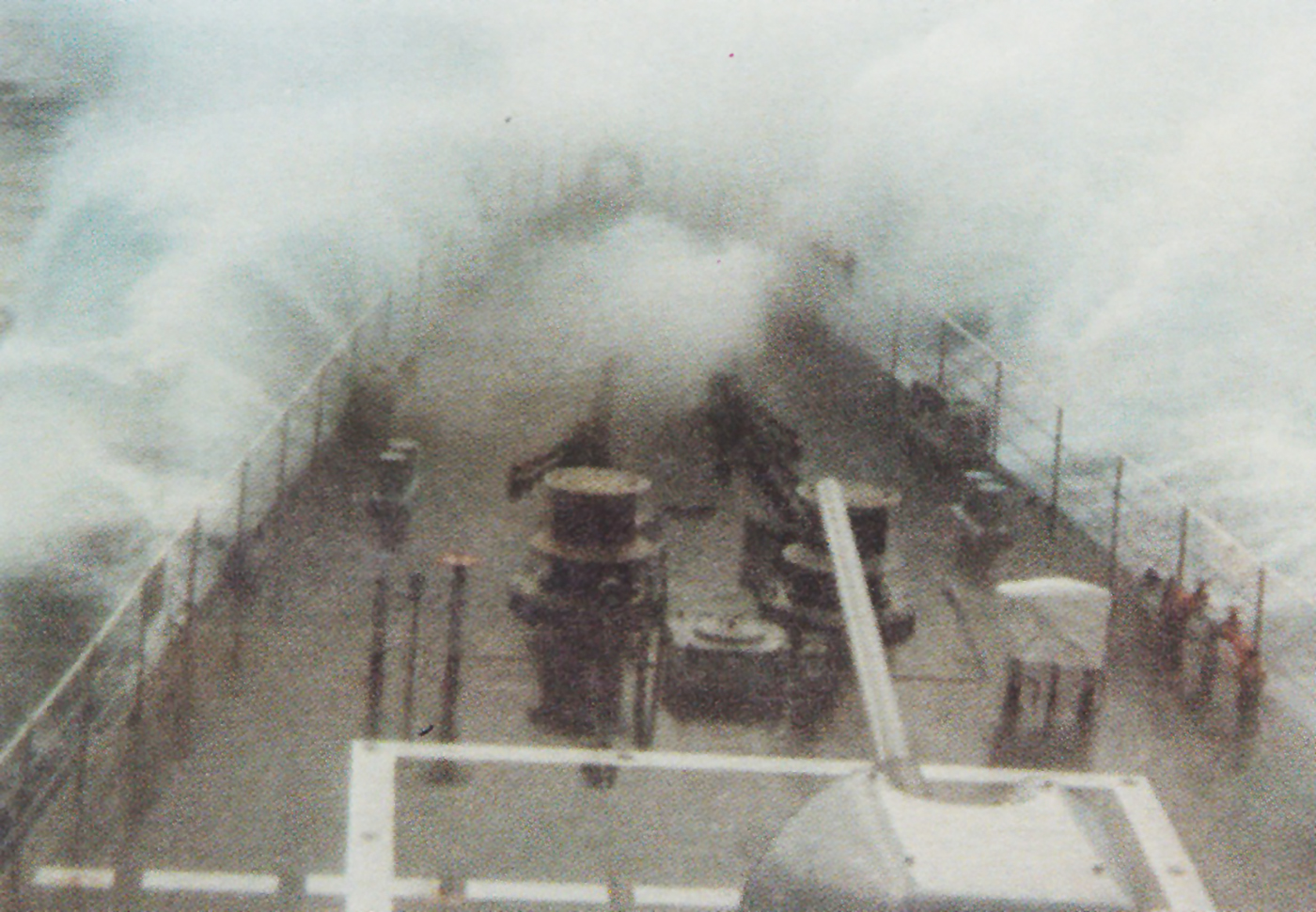
The worst things about heavy weather are exhaustion and starvation. Exhaustion because you are constantly bracing against pitch and roll and even in the rack it is almost impossible to get any rest. Starvation because the galley is shut down in severe weather and even though the cooks lay out sandwich making materials, you can’t sit down to eat it. Oh, and the Operations Specialists had clear plastic trash bags tucked under the belt to be used as barf bags; some of them obviously used.
Various ships, various times, various locations in the Western Pacific:
I hate helicopters. They are loud and ugly and inherently un-flight worthy.
The USS Sacramento, a replenishment ship, was assigned to the Kitty Hawk Battle Group. They were scheduled for a Operational Propulsion Plant Examination in the very near future and their Chief Engineer felt he needed some assistance in training his crew in Engineering Casualty Control.
The battle group was about a week from Subic Bay, so I was volunteered to take our training team over to them and run drills until we hit port. They sent one of their CH-46s over to pick us up. I was sitting on the port side of the bird as we made our approach to the flight deck of Sacramento, which is aft, overhanging the fantail.
As we were just about to land, I looked over my shoulder, out the window and saw, about two feet away, the name of the ship on the fantail. That meant the rotors were above the flight deck and the rest of the bird was below it. The pilot quickly lifted and set us down safely. He did not indicate whether that was standard operating procedure or not, but I have my own opinion on that.
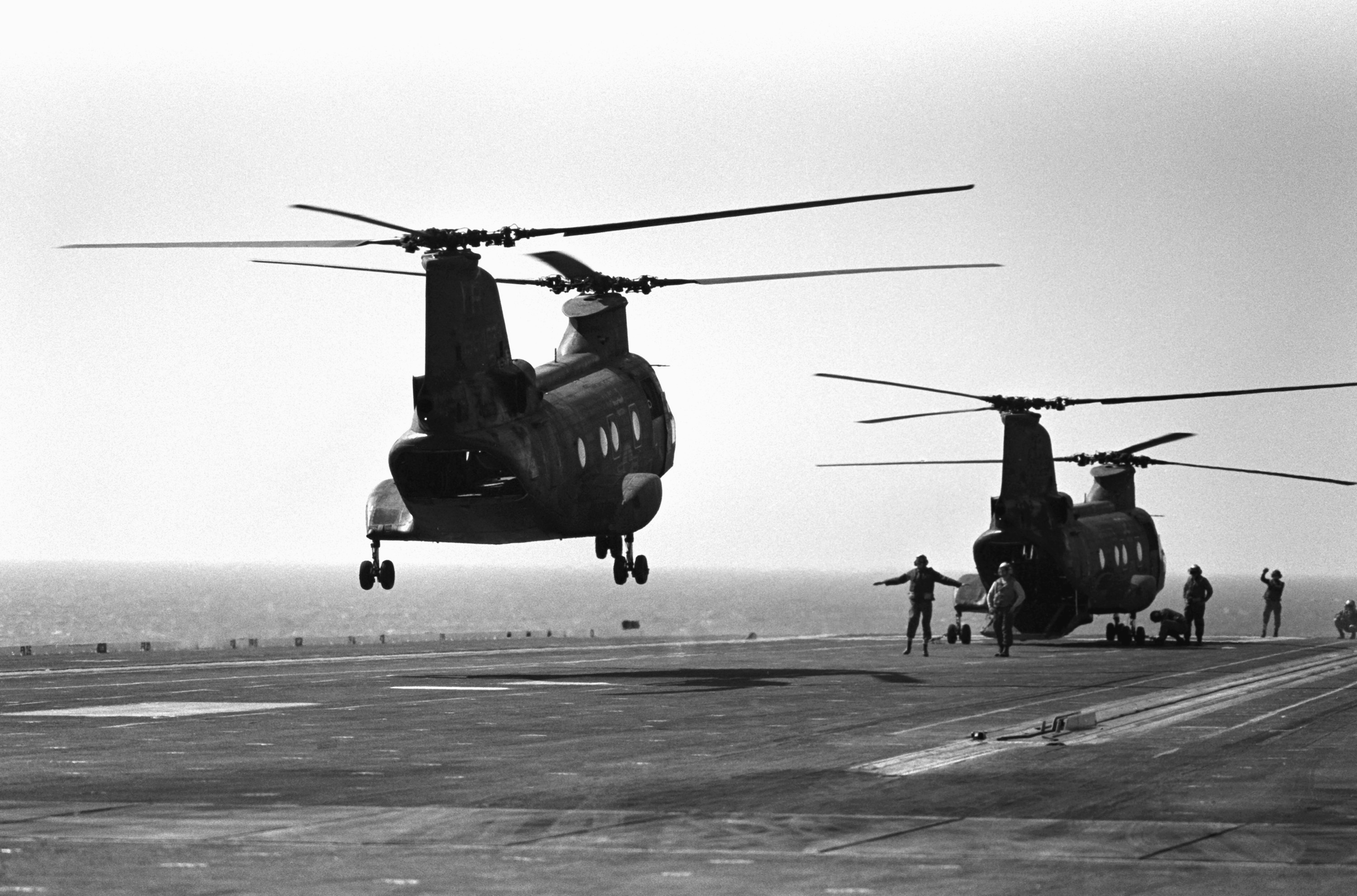
On another occasion, the David R. Ray was joining the Kitty Hawk Battle Group, with a rendezvous just north of Luzon. Prior to meeting we ran an exercise with the air wing, where they were to try to locate us while we hid among the small islands that define the Luzon Strait. They couldn’t, and as the carrier entered the engagement window of our Harpoon missile battery, we let them know by radio code that eight of them (simulated) were enroute. At exercise completion, the CO and I were requested to come aboard for a debrief and to pick up classified instructions and codes related to the battle group. They sent an SH-3 to pick us up.
David R. Ray was the first Spruance Class destroyer to deploy to the 7th Fleet, thus we were somewhat of an unknown entity. Even though our flight deck was certified to land every rotating wing craft in the Navy’s inventory, the pilot flatly refused to believe us and balked at landing. He dropped the horse collar instead, and true to naval tradition, I, being the junior in the group, was the first up to be winched aboard the hovering helicopter.
I was a stereotypical engineer. I wore coveralls, khaki of course, as often as possible. I like the smell of 2190 TEP (gear oil). I am terrified of heights. When I climbed the ladder outside the aft stack of the Henry B. Wilson to inspect it, I got a nose bleed.
I believe I have properly set the stage here.
I was winched up and when I got level with the craft, the crewman had to literally peal the collar off of me and drag me to my seat. Thankfully they landed and took off from the carrier’s flight deck to return us after the meeting. On the way back to David R. Ray, I convinced myself that it was not that bad and that I was now experienced and I would have no troubles going down. Whether it was an accident, a sudden gust of wind, or malice on the part of the flight crew, they turned me into a pendulum on the way down. Unbiased observers swear that I only swung back and forth twice, but I was there, I know for a fact that if that cable had parted, I would have been slung to Manila!
I hate helicopters!
Hot steam, cool memories
USS David R. Ray, November-December 1979, enroute and in and around the Indian Ocean to join the Kitty Hawk Battle Group moving in response to the invasion of our embassy in Teheran, Iran:
My Operations Specialists’s were children of the ’70s. Bright, but a little laid back. They knew their stuff but they were mostly first crew, so they spent a lot of time in schools waiting for the ship to be finished. A little lax in grooming, a little flippant at times, but never disrespectful. Laid back. Cool.
It was like a switch was thrown when we entered the Indian Ocean. The prospect of combat was real. To a man, they became steely eyed professionals. The horse play in the Combat Information Center stopped. The bitching stopped. Through almost three months of Condition II watches (one step down from battle stations), they never wavered. When the tocsin sounded, they went from tie dyed disco monsters to American sailors.
That was cool.
USS Kitty Hawk, sometime in 1977, off Singapore, just before midnight:
The skipper of Kitty Hawk was a cautious man. There was no way he was going to lose an airplane on this deployment. Consequently, he insisted that we have 6 of 8 boilers online every time planes were in the air. We were falling behind on boiler maintenance because we could not shut them down long enough for them to cool down. The Chief Engineer finally convinced the skipper to let us conduct flight ops with less boilers lit.
The last plane to come down had a problem. It needed more wind over the deck than we could make with four boilers and it was getting light on fuel. The skipper ordered us to quickly bring up two more boilers and simultaneously ordered up our max speed for the four boiler configuration.
As an aside, “Monday morning” CAGs (carrier air group commander) noted we could have kept the aircraft in question tanked with KA-6Ds for a long time, but who knows.
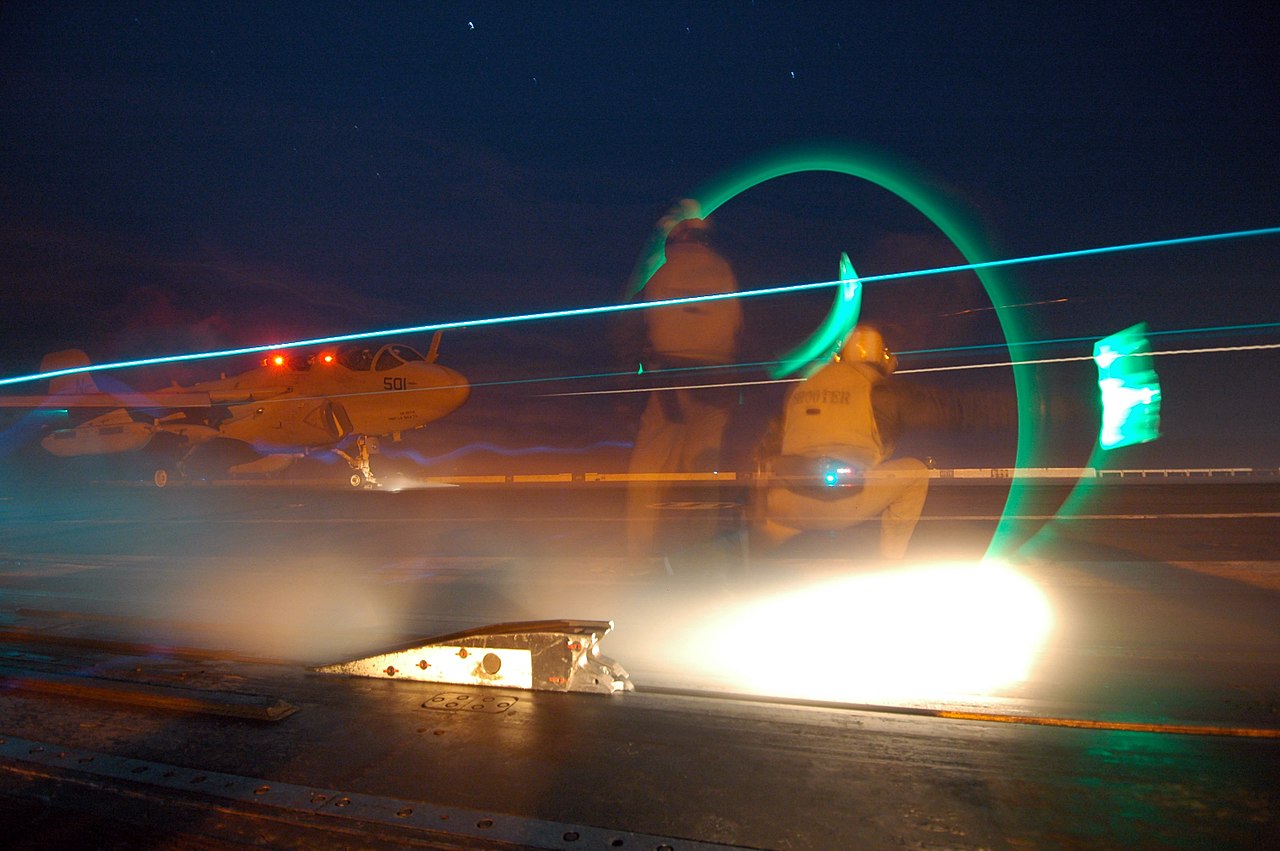
As we were pushing to bring up two additional boilers in 2 and 4 main, we lost control air (pneumatic boiler controls) in 1 main. Normally we could have handled the boiler manually, but the steaming rate was so high that the watch lost control and we had to shut down because of a low water level. Normal procedure in that case is to cross connect main steam from 4 main, but it was firing high and also in the process of assisting in bringing a second boiler online. In the end, this sucked 4 main offline.
The Engineer Officer of the Watch should have cut his losses there but in a semi panic, he tried to get steam from the after plants and they cascaded into failure. Making matters worse, as the Kitty Hawk’s whole primary plant failed, the emergency diesel engines did not start. We were hot, dark and quiet—with a plane running out of fuel.
Luckily, the pilot had enough gas to get to Singapore. Unluckily the military airfield shut down at dark and he had to land at a municipal airport—with real missiles under the wings of his jet and with their arming wires pulled. It was an international incident in the making.
Lieutenant Doug Crowder (he made two stars last I heard), and I were sitting in the Engineering log room when we heard the sounds of the world crashing down around us. We immediately dropped down to main control—a very large space that encompassed damage control central as well as propulsion and auxiliary supervisory watchstanders. He got on the sound powered communications circuit with the Machinists Mates and I grabbed the Boiler Technicians. Between us, we began to put the world back together.
One of the design features of most steam plants is system redundancy, not only in number of redundant pumps, but also in the types. Each function in the steam cycle can be performed by either a steam driven or electric pump. In cases like this, you can bootstrap a start up by bleeding steam off of a recently secured boiler, but you have to be careful, very careful. Not only is there an inherent possibility of machinery damage, but you don’t get many chances before you run out of steam pressure entirely.
Doug was talking to four different machinery topwatches and I had four boiler technician topwatches to work with. Each space had flawlessly performed immediate emergency shutdown procedures and it was time to start bringing the plant back online. Doug and I knew we were pushing the envelope and cutting corners a bit because we did not know the aircraft had already gone “Bingo” (minimum fuel to return to a recovery point) to Singapore.
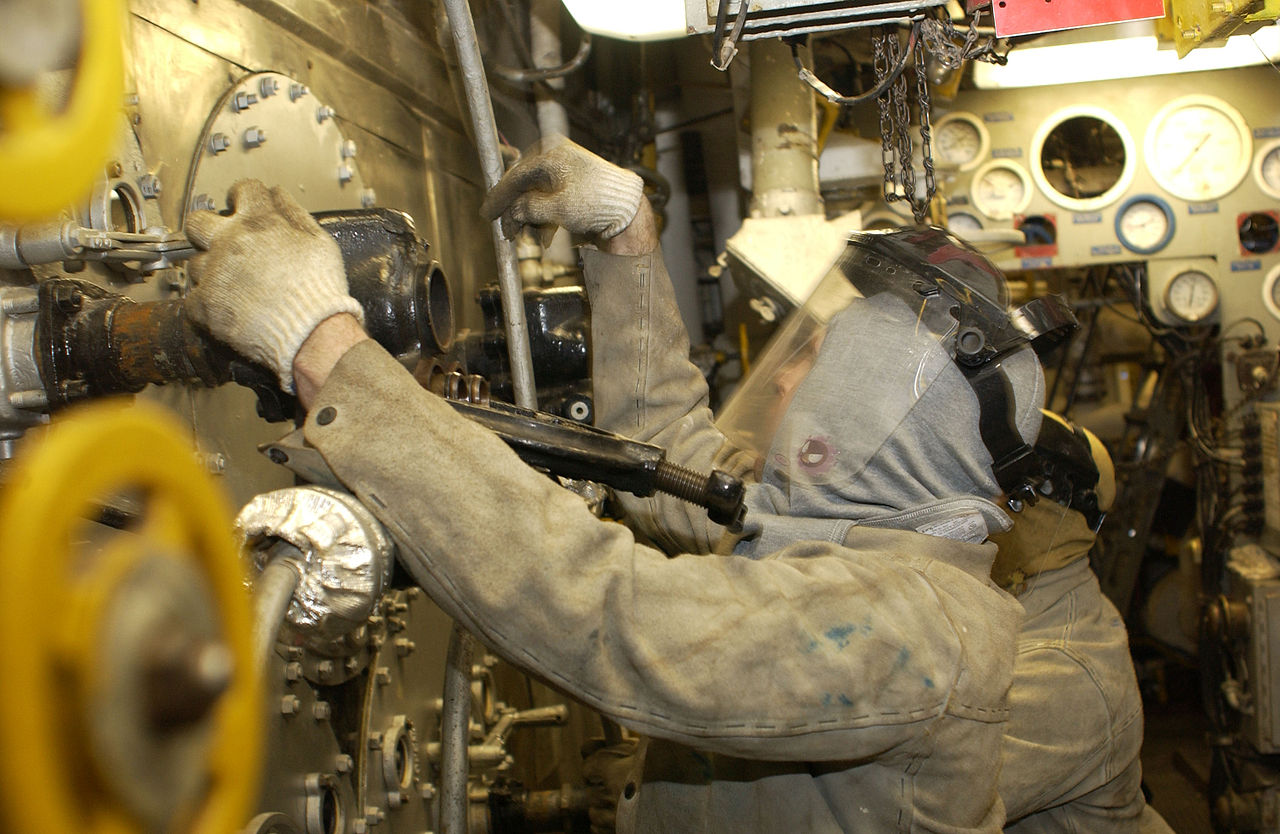
When we would order an action not in accordance with procedures, the top watches would verbally note that it was not correct and then immediately comply when we reiterated. In due course we brought the plant back up, lights on and ready to answer all bells. Sweat soaked and exhausted, we were finally able to take off our headsets and look around. What we saw was what looked like every officer on board above the rank of O-4 (LCDR), many of them wearing wings, standing in the back of main control, watching the show. From then on, we referred to this incident as the “20 Khaki Emergency.”
But our snipes had done exactly as they were trained to do, in the order they were supposed to do it, with absolutely no equipment damage or personnel injuries. All in spaces illuminated just by battery powered battle lanterns and with no ventilation in absurd heat (Singapore is almost on the Equator).
Now that was cool.
An interesting postscript. Of course an investigation had to be held and the Air Wing Chief of Staff was designated to conduct it. Except he had little or no knowledge of steam plants, so I had to give him a private lesson on high pressure steam propulsion systems— on a white board. This was well before Power Point.
USS Henry B. Wilson 1984, somewhere in the South China Sea:
Fresh (potable) and boiler feed water is distilled from seawater on these ships by a three stage flash evaporator. It is a very complicated system but just about every component can be jury rigged in case of failure, except one; the inter stage distillate pump. There are two distilling plants on this class of ship, one in each engine room. If you run a tight plant, their capacity is sufficient to feed the boiler, wash clothes and dishes and provide regular, reasonable showers for all hands.
The inter stage distillate pump had just failed on #1 Evaporator. We were a long way from any repair facility and a replacement was not carried on board.
Fortunately, we were scheduled for a refueling replenishment the next day. I cannot describe the humiliation I felt when I had to go to the ops officer and ask him to request feed water as well as a replacement distillate pump for the next scheduled replenishment.
The oiler had good water and were glad to provide it us. Only one problem. Tank levels on this class of ship are determined by dropping a graduated measuring tape down a sounding tube, then pulling it up to determine the level in the tank. These levels are reported by sound powered phone to the Oil Lab, where the Oil King has a table that correlates level to tank capacity. He is in communication with not only the men on the sounding tapes, but also those standing by at the valve manifolds who open or close valves as necessary to direct the fluid to the proper tank. The same procedure applies to feed water tanks. The problem? There is only one sound powered phone circuit for both water and fuel tanks.
The Oil King took the fuel on-load and I took charge of taking on the water, because if I screwed up, water is much easier to clean up than diesel. We took on a full load of fuel and topped off our feed bottoms without spilling a drop of either liquid. The men maintained perfect circuit discipline and never missed a sounding or a call to redirect to a new tank. Humiliation and pride, what a combination.
That was cool.
USS England Spring 1986, pierside Naval Station San Diego:
I always maintained a very good relationship with the crew, regardless of whether they worked for me a not. They knew that I appreciated what they did and how hard it was. It may have been partially due to the years I wore a white hat (enlisted sailor) but mostly it was a feeling of mutual respect. I did not knock down the wall between officer and enlisted men, but we certainly leaned on the fence and had conversations.
On Friday nights underway, I would relieve the junior officer responsible for sampling the crew’s mess of his duties and would get behind the serving line. As each sailor came by to get his portion of whatever I was dishing out, I would offer some sort of comment or greeting. After the initial surprise wore off, most of them came to look forward to the interaction, asking me where I had been on those nights when other duties interfered.
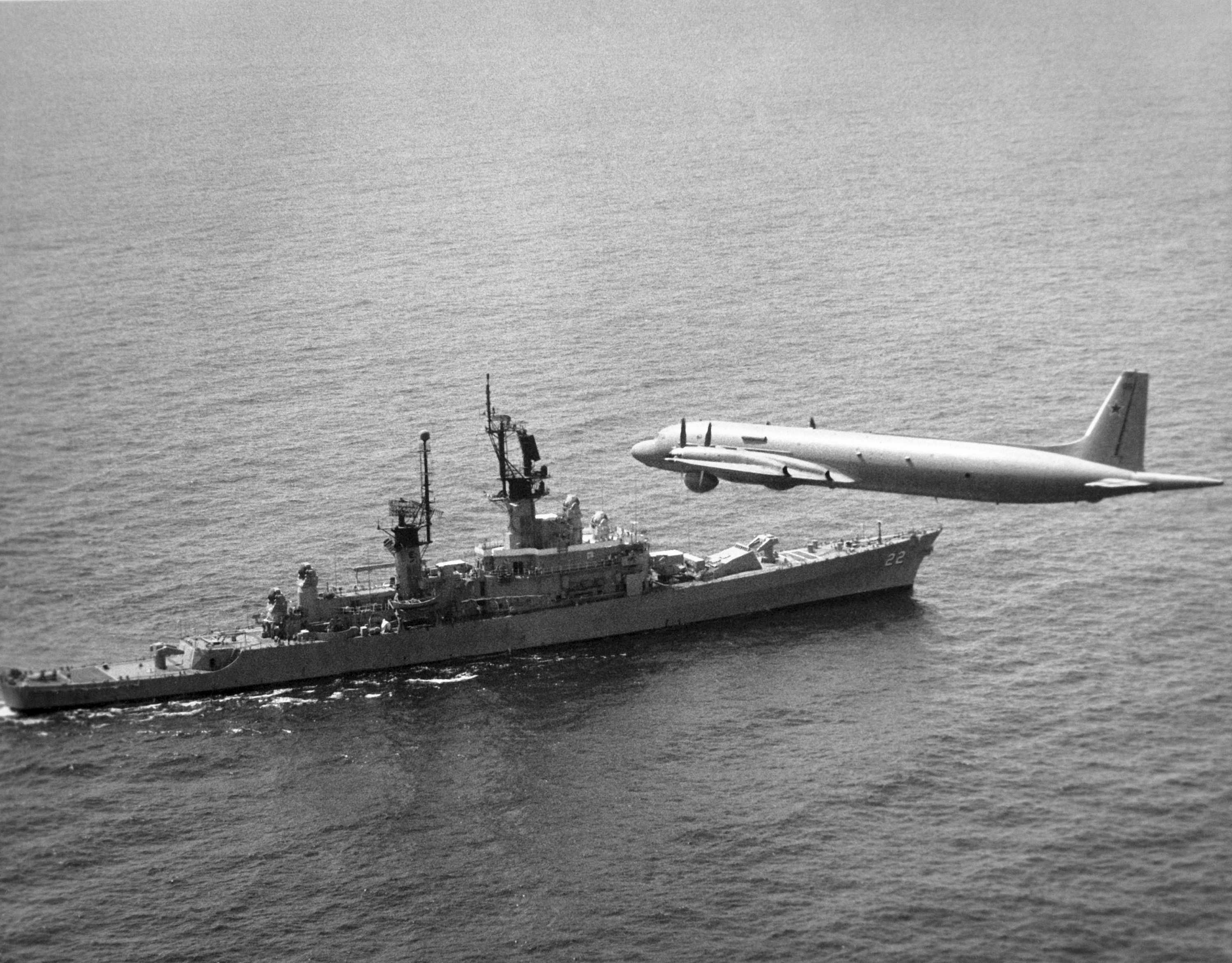
I have said many times that one of the toughest jobs in the Navy was being my Auxiliary Officer—the man responsible for things like galley and scullery equipment. It was well known that I considered the mess decks the most important space on the ship because a well fed sailor, while not necessary a happy sailor, is certainly a nourished sailor. I would go out of my way to traverse the mess decks regularly and it was the first space I visited when I came aboard mornings in port, even before I had changed into my uniform. If the trash cans were full of paper plates (scullery down) or there were big jars of peanut butter and loaves of bread out (ovens or coppers down), then the next thing you heard over the 1MC was “Aux Officer, report to the Chief Engineer”.
I did not however have as cordial a relationship with the commanding officer. He demanded personal loyalty, I offered only loyalty to the Commanding Officer, USS England. There is a difference.
The only time I failed to get underway on time was when he authorized, over my objection, major high pressure piping repairs. I knew that it would not get done in time. His buddy, the CO of the tender, needed work for his high pressure welders.
We passed every engineering inspection, we got kudos for our maintenance coordination with WESTPAC repair facilities and we kept the lights on and the Combat Systems energized and cool for 18 months. But I would not sign on to his attempt to railroad a young officer nor would I direct my warrant officer to go on the pier and fix his car.
The XO warned me that he could kill me with a bad fitness report, but I had already been selected for Engineering Duty Officer, and as I told the XO, I was already four pay grades higher than I ever thought I would be and the only way he could hurt me with a FITREP was to roll it in a cone and poke me in the eye with it.
When I was relieved, with orders to postgraduate school, he called me into his in-port cabin, gave me a lousy FITREP, and rushed me off the ship. My officers and chiefs hardly had time to get to the quarterdeck to see my off. I left the ship feeling a bit down, but as I walked down the pier, I looked up at the forecastle of the ship and saw that the 1st Class Boatswain’s Mate had all of First Division in formation, rendered a salute and piped me down the pier.
Now that was very cool.
But above all else, going to sea and making steam is just cool.
The trappings of a good commanding officer
Most commanding officers (COs) were nothing more than politically astute bureaucrats, each hoping that their sea tour would not interfere with their hoped for shore tour that would lead them to a star (becoming an admiral). I will not address them further. But there were two that were the exception.
Nuke (nuclear) officers are seen as technocrats with no imagination, tackling problems with their nose to the grindstone and an eye on the plant manuals. Kind of hard to have any long term vision in that position, no? Rickover’s mantra of “you get what you inspect, not what you expect” does not lead to very much leadership development in your subordinates. Although, perhaps it is warranted—the old Navy nuke saying “more people have died in a car driven by Ted Kennedy than in any U.S. Navy nuclear power accident” still applies.
Both of the COs to whom I refer were surface nukes, auditioning, as it were, for command of a nuclear powered surface combatant. There were so few nuclear powered surface ships then, or ever for that matter, that conventional surface ships served to weed out those that were not up to a major command. CVN (nuclear carriers) COs had a different criteria, one reserved for Naval Aviators.
Commander Tom Gilmartin was my second CO on Henry B. Wilson. He was a solid, quiet man who utilized his department heads to the fullest, did not pretend to know the weapons (WEPS) and operations (OPS) officers’ business better than they did, but was smart enough to ask the right questions and not be buffaloed. Except for the boilers, he may have known my business as well as I did. Well, almost, but not quite.
I got off on the right foot with him from the very start, I think. Less than a week after he took command, we got underway for local operations. As soon as the word was passed, “underway, shift colors,” I got on the 21MC (an internal voice communication system) to the bridge and asked the Boatswain’s Mate of the watch to pass to the CO, “underway on fossil fuel.”
It was a Rickover requirement, which became a tradition, that anytime a nuclear powered ship got underway, from the days of USS Nautilus, a radio message was sent to the Chief of Naval Reactors, “underway on nuclear power.” I believe he enjoyed it.
Commander Fred Triggs was my second CO on USS David R. Ray. The man he relieved drove a BMW. CDR Triggs drove a Volkswagen Thing. Orange. No roof. Ever.
Fred Triggs was the first and only man under whom I served for whom I would have willingly strapped on a steel helmet and “gone over the top” for. In the decades since, I have spent many hours thinking about what made him so special. Each attempt at analysis only results in a series of memories, a few of which I will share in the hopes that the sum of their parts will lead to an appreciation of the whole.
If I were to describe him in two words, those two words would be unflappable and consistent. He was a tall, thin, balding man with a prominent hawk like nose. From years of ducking through water tight doors, he was slightly stoop shouldered, but that only tended to enhance his position as “Captain and Commander” when he loomed over you, asking probing questions.
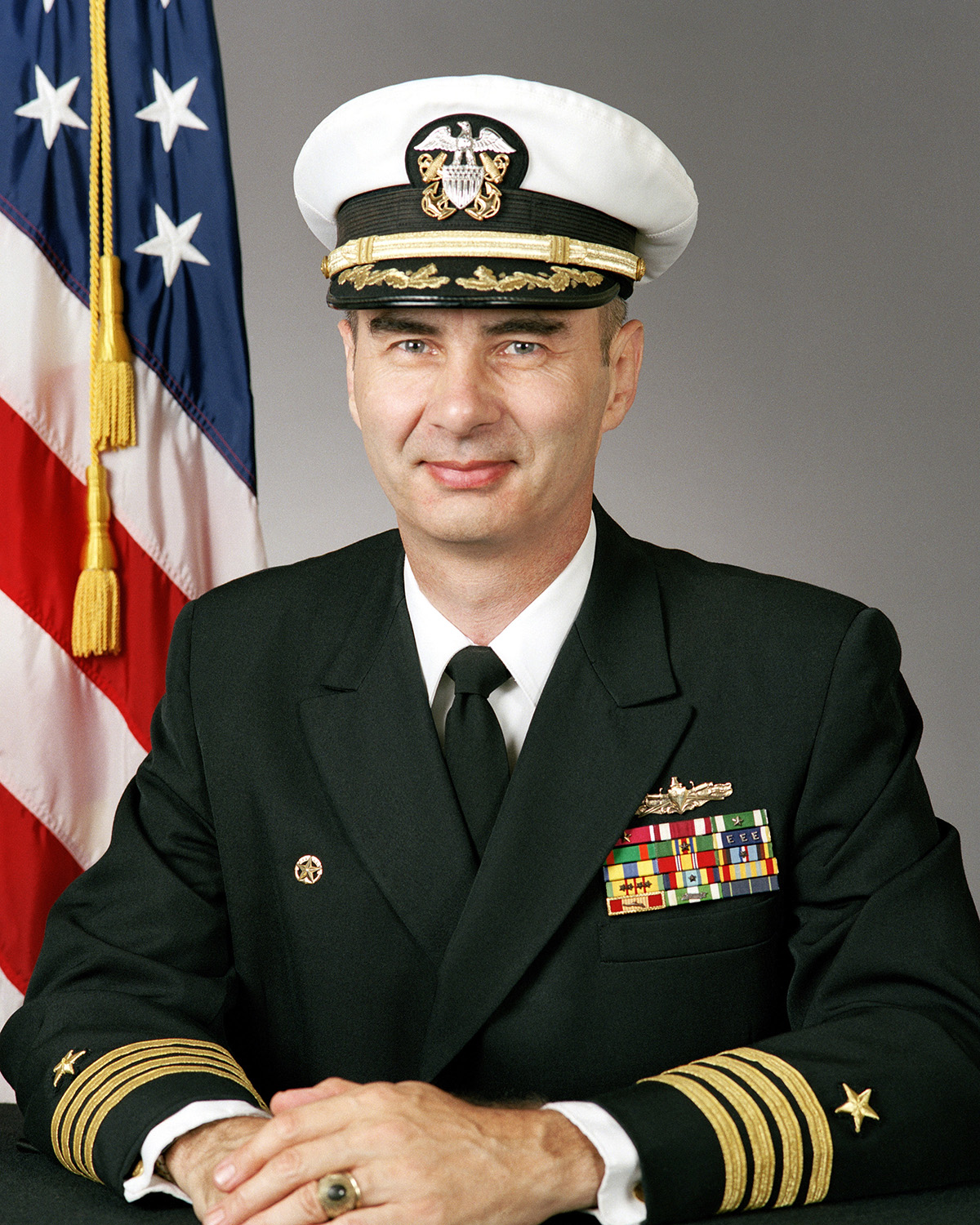
As the Combat Information Center (CIC) officer, I wrote a lot of Naval messages, which had to be walked through the chain of command and “chopped” for release. I recall carrying a routine message through that gauntlet one evening after dinner to the Captain in his sea cabin, where I found him engaged in intense study of the Propulsion Plant Manual. He turned to me with an upright index finger in front of his mouth in the “keep quiet” gesture, winked, and said “don’t tell the Chief Engineer!”
We were deployed with the Kitty Hawk Battle Group to the Western Pacific at the end of 1979 and ended up supporting the aborted rescue attempts of the Tehran embassy personnel. In those operations we were underway from the week before Thanksgiving until just about Valentine’s Day, with only a short respite at Diego Garcia to change out an engine.
The Chagos Archipelago, which Diego Garcia is a part of, does not count as a liberty port. Unlike Adak, Alaska which is rumored to have a girl behind every tree (no trees on Adak), Diego Garcia has a coconut crab behind every lump of coral.
Around Christmas time, when we had finally stood down from some pretty tense periods boring holes in the water just south of Iran, my Operations Specialists (OS) decided to make CIC a bit more reflective of the season and put up a lot a homemade decorations around the space. Captain Triggs came through the space enroute to the bridge, stopped, surveyed the situation with storm clouds forming on his brow, then with the facial weather clearing, nodded slightly as if to say to himself that the decorations did not get in the way of the performance of duty and certainly helped morale, and went on his way.
On New Year’s Day, he once again came through on his way up to the bridge and without slowing down, said in a conversational tone to no one in particular, “Christmas is over” and continued up the ladder. All decorations were gone within fifteen minutes with nary a gripe from any of my men. On the other hand, he saw a Playboy pin up underneath the glass on our chart table before I did and he made it clear to all concerned that it was not acceptable. It was removed even quicker than the decorations, with no muttering this time either.
During the same time, my wife got together with the rest of the Officers’ Wives Club and put together small Christmas gifts for the entire wardroom. She sent the package to Captain Triggs and on Christmas Eve, he got the stateroom master keys from the Chief Steward and delivered all of the gifts personally. A small thing perhaps, but something that cemented the bond between a good skipper and his officers.
Captain Triggs loved airplanes. If we were controlling any aircraft, either for anti-submarine operations or air intercept control of fighters, he was monitoring the circuit on a headset. In the late ‘70s, the Air Force was desperately looking for missions for their B-52s. Someone decided that they might be good for open ocean surveillance of surface craft and developed an exercise called Sea Crow, where a mission of three B-52s from Hawaii would search for naval vessels transiting from San Diego to Pearl Harbor. We were nominated to be the target of one such exercise and after they finally found us—I don’t think the Air Force realized just how big the Pacific Ocean is and how small a destroyer is, in relation to it—the mission commander requested permission to make a “low pass” before heading back to Hickam AFB on Oahu.
Everybody on the bridge knew how Captain Triggs would respond to that! The first visual we got of the bombers was a black smudge on the horizon from about 295° to 055° relative. The smudge got bigger and wider until we saw three of those behemoths, almost wingtip to wingtip, flying straight at us, seemingly 50 feet off the surface of the water. As they flew overhead, the roar of their engines was overwhelming and I happened to glance at the Captain just as they left us astern.
I have never seen a happier man.

I had the deck on the midwatch in the South China Sea. We were in a very loose formation, the Kitty Hawk had been flying night quals (qualifications) earlier, but things had settled down. The aft lookout reported a strobe light in our wake, which was most likely from a life ring, indicating a possible man over board. We quickly initiated all of the actions drilled into us since we first started thinking about driving ships—man overboard announced on the 1MC, alert all ships in company, hard right rudder to immediately take the reciprocal course, then another hard right after passing the point where the light was first sighted as input into the navigation computer, then returning on the original course to hopefully locate the ring or man overboard.
I was mentally patting myself on the back as I stopped the ship upwind and within 5 feet of the ring, allowing the Chief Boatswain’s Mate to retrieve the ring—a quick muster revealed that all hands were accounted for—when I heard a voice, seemingly from the overhead. Remember I said Captain Triggs was tall and I top out at five foot six.
“Would someone please tell the Commanding Officer just what the hell is going on here?” It seems the Boatswain’s Mate of the watch had neglected to switch on the circuit of the 1MC that sounded in the Captain’s sea cabin and I had been too busy to call the Captain on his phone, or to tell the Junior Officer On Duty (JOOD) to do so. I think the fact that we did not lose anyone, we had followed (almost) all of the correct procedures and, if I do say so myself, it was a handsome bit of ship handling, saved me from too much of an ass chewing.
The Junior Officer Of The Deck (JOOD) told me that the skipper had been there for quite some time and had seen the whole recovery—the exclamation was simply for effect.
We had been detached from the Kitty Hawk Battle Group and were proceeding independently to Subic Bay, then Pearl Harbor, then home. We were steaming along the northwest coast of Palawan Island, a long narrow island between Borneo and the Philippines, an area with a significant amount of local traffic. I had the midwatch as Officer Of The Deck. The Captain was in his chair on the starboard side of the bridge. We had been ducking around fishing boats and tramp steamers for quite a while but we had few options. To starboard was Palawan and to port was a chain of small islands and shallows.
For about an hour we had been tracking a medium sized target that appeared to be on a reciprocal course. Because its Closest Point of Approach (CPA) was tracking to be much closer than any of us were comfortable with, we had been trying to contact them on the commercial UHF bridge to bridge radio, but had received no response. As they were almost abreast of us, they made a sharp turn to port, right in front of us.
I immediately ordered hard left rudder and we narrowly avoided a stern to stern collision. After we were clear, the freighter finally contacted us on bridge to bridge radio with a barely understandable message that basically boiled down to “oops, so sorry.”
Captain Triggs picked up the mic, and in a stern voice, quoted chapter and verse from applicable maritime law and regulation, pointing out the error of their ways, finishing up with “you have embarrassed me mightily!” and hung up the mic. No screaming, no curse words. A true professional.
Perhaps the distillation of the type of leader Fred Triggs was can be displayed from the last time I saw him. We transited home from the Philippines independently. No other ships in sight for most of the transit. Same course and speed for days. We used to beg the Senior Watch Officer for a chance to take the watch when we made a course change. It was tough keeping the lookouts and other enlisted watchstanders on the bridge awake during the night time watches. To keep their attention I tried to engage them in non-naval conversations. We eventually got around to movies, then musicals. One of the trivia questions we were unable to answer was the name of the woman who co-starred with Yul Brynner in The
King and I.
When we returned home, I received orders to be an instructor at Surface Warfare Officer’s School. At my hail and farewell, after my department head said nice things and I had received my ship’s plaque from Captain Triggs, he shook my hand, drew me in close and whispered in my ear “Deborah Kerr.”
He understood what I had done and why. He monitored to ensure it did not interfere with the safe navigation of the ship and left me to execute my duties and responsibilities effectively, if in an unorthodox manner.

Five things the Navy can do today to make it a more effective fighting force
1.) Do what they did in 1942—fire the politicians and promote the warriors. Reduce the number of admirals. Find a way to re-emphasize that the duty of a Naval Officer was keeping the best trained, best equipped, best maintained vessels at sea. And it wouldn’t hurt if the non-uniformed politicians had a more consistent, achievable and responsible definition of the Navy’s mission.
I urge them to refer back to A.T. Mahan—keep the sea lanes open and protect American shipping. Nation building and the spreading of democracy to disjointed peoples who have no concept above the organizational level of the clan is not the job of the US Navy. Nor is it a testbed for the tree huggers. Budgets are tight enough without spending inordinate amounts of money on bio fuels and considering the environmental impacts of every exercise. The Navy exists to protect this nation, not save the world, which any rational individual would agree, does not need saving. I refer you to Bjorn Lundberg’s “Skeptical Environmentalist” for affirmation.
2.) Get the experienced technicians back in front of the classroom. The Naval training establishment has been hypnotized by the flashing lights and glitter of computer based training. Yes, I know that personnel costs are the biggest driver in any operation, especially training, but you cannot create a maintainer/operator by sitting him down in front of a computer and letting him mash keys, no matter how animated and interactive the training module is. Tell that sailor that he could go on liberty after he finished three modules and you will see Einstein invalidated.
I went to EM “A” School in 1970 and I still remember many of the things that the crusty old EM1 standing in front of the classroom, with jokes penciled in on his lesson plan, taught us. Not only did we learn about our rate, but we learned a lot more about what it meant to be in the US Navy. After I retired, I had a job managing three contracts with NAVSEALOGCEN to install, update and logistically support all of the Navy’s Technical Training Equipment. TTE is classified as actual systems or subsystems installed in a training facility to allow hands on training opportunities. Very little TTE exists anymore. I do have to note that this may be changing.
A few years ago a retired Admiral was asked to analyze root causes of the poor state of maintenance in ships and he zeroed in on computer based training as a prime factor. Changing this would upset a plethora of rice bowls, so I am not sure if anything has happened subsequent to his report.
3.) Re-establish Surface Warfare Officer’s School (SWOS). This was eliminated in the SWO pipeline as a cost saving measure. At the risk of sounding parochial, I went on board many newly commissioned vessels in the course of my responsibilities representing NAVSEA Philly for new acquisition logistics. With no exceptions, I found the Ensigns and Lieutenants Junior Grade Officers woefully uninformed about their jobs and responsibilities. They did not know what or how to fill the role of Division Officer, which was the mission of SWOS.

4.) I barely survived the Zumwalt years. The campaign to restore pride and professionalism saved the US Navy. Seemingly simple things like re-establishing grooming standards and restoring some of the myth and lore of the mariner rippled positively throughout the entire fleet. Putting dungarees back on the sailors and calling it the mess decks instead of the Enlisted Dining Facility may seem trivial, but things like that are part of what makes a hard profession worthwhile.
Over the past few years, I have seen a similar erosion of professionalism, seemingly starting at the top of the force. I was in Bath, Maine for a logistics review on the USS
Zumwalt DDG-1000 construction. At lunch in a local chain restaurant, I saw a young man walk in wearing a combination of blue, khaki and white, with a 3rd class crow on his arm. I was certain he was one of those people who tried to steal some glory, but a quick internet search showed it was a real uniform. And I am aware that the brass in the Pentagon is jealous of the generals and colonels running around in the desert cammies and had to have something similar so they could look like warriors, too. But, if you were to fall over board, would you really want to blend in to the surroundings? Carrying this argument forward, on the theme of restoring the Navy to a military organization, not “Google with uniforms”—that loud klaxon you hear in the background is the politically correct alarm going off.
Here are some thoughts: ships at sea can be thought of as emotional thermos bottles. There is no home, or bar, or club to go to after work to release those emotions. The average age of a sailor is still around 19 or 20 years old, I think. They epitomize emotional creatures. I will not get into any discussions about the physical disparities between men and women in combat, the Marines seem to have that one covered. But anyone who denies that young men and women, or young women and old men, sealed up in that emotional thermos bottle will become emotionally or physically entangled has no understanding of human nature. Chiefs and officers will treat young women differently, young women will use their looks and sex to influence their superiors. Sailors will fall into and out of love. Other sailors will be jealous because they can’t. Life underway is tough enough without adding those kind of volatile situations.
The purpose of the United States Navy is to protect our shores and our interests on foreign shores, not to provide a vehicle for advancement and self fulfillment to any one person—male, female, transsexual, transgender, or homosexual. The inclusion of any of the latter four on a warship degrades readiness and the ability to achieve the mission.
5.) Decrease the civilian shore establishment. Re-designate those functions to sailors. It will give them some reduced stress shore duty where they can spend time with family and decompress. Yes, I know about personnel costs, but I think this would really help retention and improve accountability and productivity.
Incorporating untested technologies into the supercarrier USS Gerald R. Ford
Evolution is far more affordable (and less risky) than revolution. The object of any aircraft launch and recovery innovation is reduced cycle times. That was the driving force behind both the Electromagnetic Aircraft Launch System (EMALS) and the Advanced Arresting Gear (AAG).
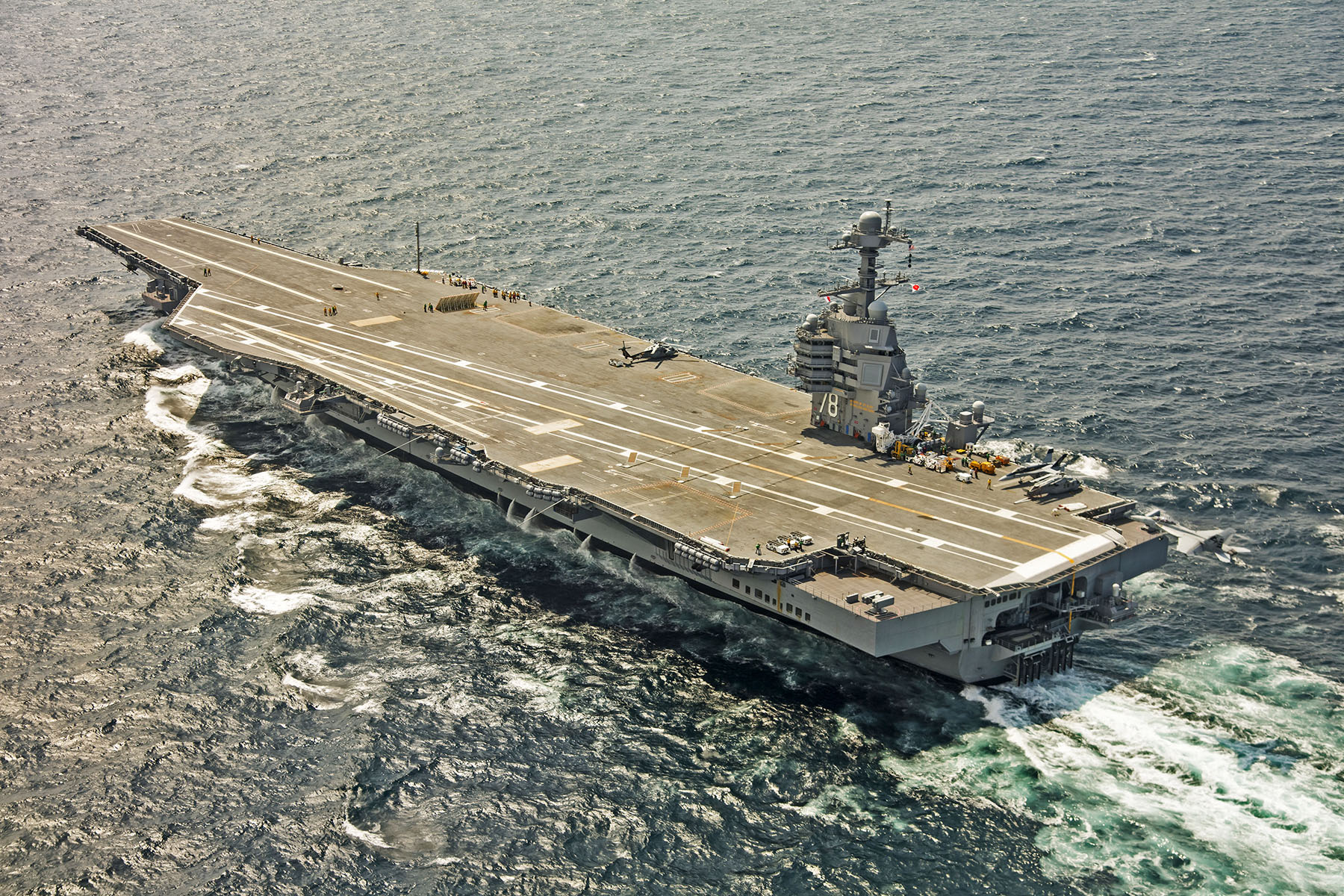
An additional factor arguing in favor of EMALS is that high pressure steam is no longer involved. That removes the significant weight of the catapult steam receivers, usually located above metacentric height, thus increasing stability. By not using steam pressure as the motive force, you reduce the need to generate steam, thus improving total plant economy. Quite frequently, condensate from steam catapults was contaminated and thus the cat drains had to be cut out from the condensate system. Not using steam reduces losses, thus increasing efficiency.
Sometimes bright ideas are so fascinating that they assume a life of their own. They attract adherents that become disciples rather than advocates. The major acquisition cycle is so long that by the time that signs are starting to appear that cost and schedule goals are in jeopardy, it is too late. The earlier proponents of the system have already been awarded their Legions of Merit and have moved on to bigger and better things. Current managers are faced with a dilemma: redesign, with all of the associated cost and delays, or push ahead in an attempt to overcome all obstacles. The “can do” spirit has knocked down many barriers in the past. Perhaps by the time the next carrier in line is ready for installation, the bugs will be worked out. How many very expensive aircraft end up in the water before that happens is hard to predict.
But, I do not think it is appropriate to assign a right or wrong to the decision to go forward. There may have been early signs that the projects were in trouble and no one noticed or they were hidden, but I cannot say one way or another. The Navy has run with many unproven systems before and has overcome some mighty big growing pains. The story of the first ship with superheated steam boilers is informative in that regard.

My biggest issue with EMALS was concerning future sustainability. Some of the components were naturally the responsibility of NAWC Lakehurst, the aircraft launch and recovery equipment In Service Engineering Agent (ISEA). Others components, because of their similarity to those developed for the propulsion system on Zumwalt by NAVSEA Philadelphia, were under the technical authority of the engineers in Philly. It was obvious to me, and my NAVSEA Philadelphia sponsor (Acquisition ILS Program Manager) that someone needed to be responsible for the entire system. Repeated requests to both the NAVAIR and NAVSEA senior management for official designation of such a responsible entity were treated with a response that indicated a major lack of concern. It has been my experience that if a system does not have a single responsible entity charged with life cycle sustainment, it falls victim to neglect or competing agendas.
The Navy’s DDG-1000 Zumwalt class stealth destroyer
The fever dream to design and build the most technologically advanced surface combatant has entranced Navy planners for decades. The DDG-1000 program, originally called the 21st Century Cruiser back in the late ‘80s and early ‘90s, is the embodiment of that dream.
The program had two goals, reduced observability—acoustic, electromagnetic and visual—and reduced manning—which evolved to Optimal Manning and now they don’t talk about it much as that goal became more elusive.These goals were to be accomplished using the most gee-whiz electronics and computers they could get their hands on.
Technological advancements in the mid ‘90s gave a boost to planners’ imagination. The development of the Insulated Gate Bipolar Convertor (IGBT) opened up a whole world of possibilities. It was already determined that the new ship would not have a standard propulsion system. A great vulnerability of conventional shipboard power transmission systems was the shafting connecting propulsion systems to the propeller. Battle damage to the shaft, which generally runs at least half the length of the hull, reduces maneuverability by half, with no bypasses or workarounds available. Using electric propulsion motors located far aft, this vulnerability is greatly reduced as the severing of one power line can be overcome by re-routing power, either through temporary or installed, fixed cabling.
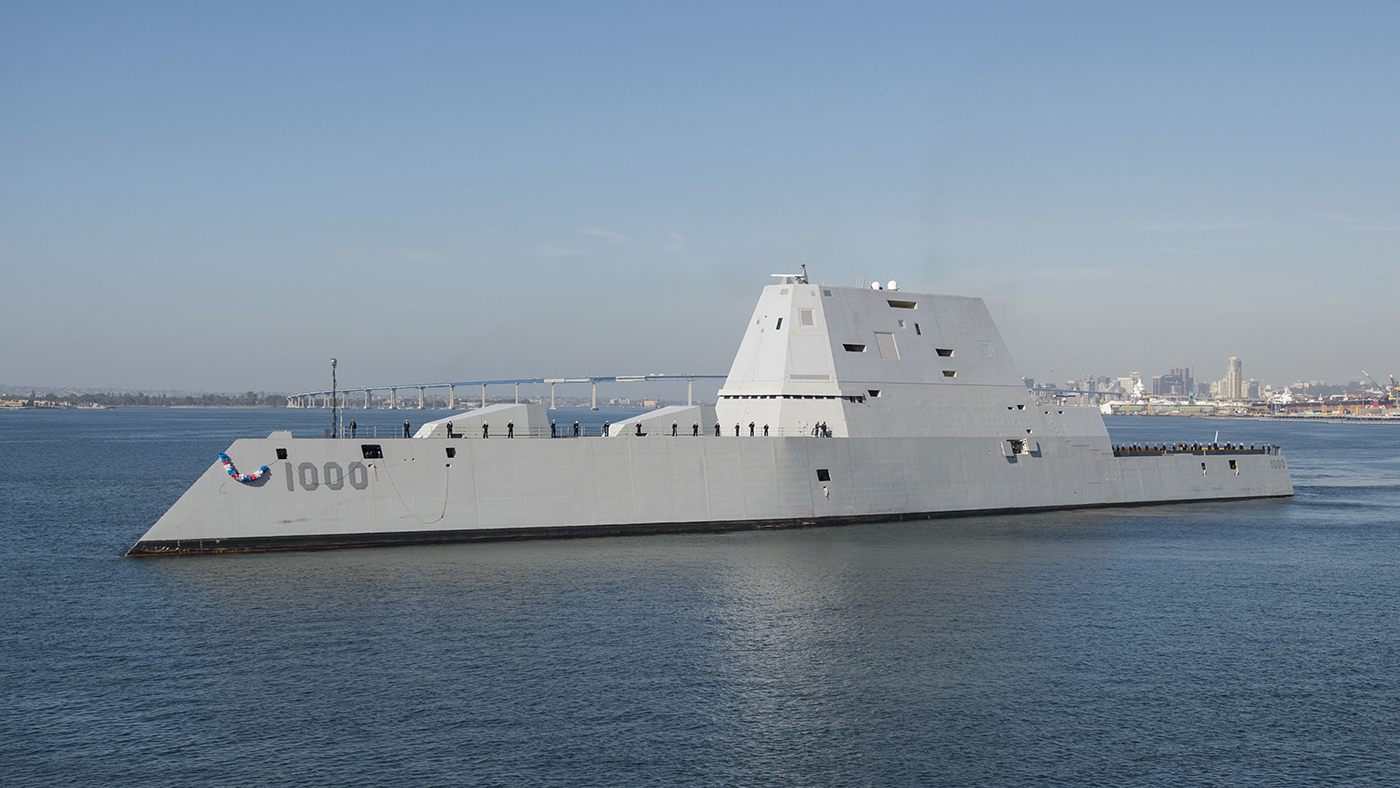
The speed of an alternating current motor is determined by the number of electromagnetic pole pairs fabricated in the design and the frequency of the electrical current applied. Since the number of pole pairs is fixed and there has been no way to alter the frequency of high voltage electricity, an alternating current propulsion motor was not possible. Direct current motors were feasible—they had been used for decades in battery powered motor generator sets and propulsion motors on diesel submarines—but they were a maintenance nightmare, particularly because electrical energy had to be applied to the rotor by carbon “brushes” riding on a rotating ring. The carbon dust arising from that contact and the frequent requirement to replace brushes and to ensure the slip rings maintained a smooth and regular surface created a significant cost in time and manpower.
Enter the IGBT. It had been possible to alternate the frequency of very low output voltage transistors for decades. The IGBT could handle megawatts at tremendously high voltage. Now it was possible to design and build a AC propulsion motor. Actualizing that potential took years and millions of dollars. The engineering spaces of the DDG-1000, instead of pipes and valves and pumps, now has rows and rows of electronics enclosures. There is so much potential danger from high voltage arcing that personnel are not allowed in the space during times of restricted maneuvering without special arc suits and face shields.
But that was not the only radical innovation the planners envisioned. Most new classes of ships employ one or two innovations in their design. The DDG-1000 program has nineteen or twenty, depending how you count. There might have been more but early development and design issues eliminated some.
For example, at one time the idea was to include a maintenance planning and scheduling system. A system would have a problem and diagnostics—either automatic or human—would determine the cause. The work item would be entered into a computer console and immediately the computer would order the part, schedule the work at the appropriate maintenance level and info the tactical computer of the operational limitations the fault imposed. Needless to say, Navy infrastructure was not ready for that.
Of course, with a new ship, you had to have a new gun. To get the support of the Marine Corps, it had to be big. To achieve the goal of low observability, you had to hide it. And to justify all of that cost, it had to be able to launch a projectile halfway around the world that would find its own target and broadcast “have a nice day” to its intended victim before plunging into its superstructure.
To meet their goals and to satisfy their lust for innovation, they violated many written and unwritten nautical rules. “We don’t need windows on the bridge! Let’s install flat panel monitors everywhere and feed images to them from cameras mounted all over the weather decks!” That would be cool, besides power fluctuations never harm solid state devices and electronics never suffer from exposure to salt spray and camera lenses never fog, which is good because we have mounted them where no one can reach them to clean them. And that old saw about visually checking that you are clear from shipping by stepping out on the bridge wings before ordering a turn is so passé, we don’t need bridge wings and besides, we got those cameras!

To meet their manning goals it was absolutely necessary that every crew member was qualified to stand the watch associated with his billet. That meant they had to be qualified before they came on board. This was to be accomplished by a crew support facility in the home port where, through Computer Based Training, each prospective crew member was to be certified for their designated watchstation. Notwithstanding the obvious cost of this plan, and the doubtful success of qualifying a watchstander without actually standing a watch, I can think of nothing more de-motivating than to realize that you were going to stand the same watch, with the same duties, for the entire time you were on the ship. You could not move up or laterally because there was no one there to take your place.
I mentioned the floating manpower definition. Every time a manpower analysis was done, either because the maintenance requirements became better known as the design matured or because somebody pointed out something had been forgotten, the manning levels had to increase. Soon they realized they would have to institute a “hot bunking” protocol or expand the berthing compartments. There were not enough non-rated sailors to accomplish routine tasks like sweep down and mess cooking. As you could probably surmise, the plan to have no watchstanders in the engineering spaces during normal underway ops had me climbing the walls.
As an aside, the Spruance class was one of the first attempts at reducing crew size. The ships were filthy and always showed running rust because there were not enough non-rates assigned to perform basic duties.
The DDG-1000’s rapid cost escalation should surprise no one. When program costs are initially estimated, the costs of research and development, production facility establishment and the purchase of bulk and long lead time materials is spread out over the original number of hulls. When that number is reduced from 15 to just three, of course the price per hull is going to skyrocket. The same can be said for the ship’s Advanced Gun System’s LRAP rounds. When you amortize your production line start up costs over 30 magazines, plus 15 ships worth of stores ashore and then your production requirements are drastically reduced, of course the cost per round is going to go through the roof.
You may think from reading the above that I think the entire program was a waste of time and money. If the Navy does not learn some valuable lessons from the program perhaps it will be. But if some good comes out of the technologies as they mature or if we stop trying to make such giant leaps forward, then at least something positive will have been achieved. Forgive my skepticism when I say that I have my doubts. There was nothing I liked about the program from the shape of the hull to the name of the first ship. Although that choice was somewhat prophetic, in my mind. CNO, Elmo Zumwalt pushed many innovations, most of which had a negative impact on my Navy.
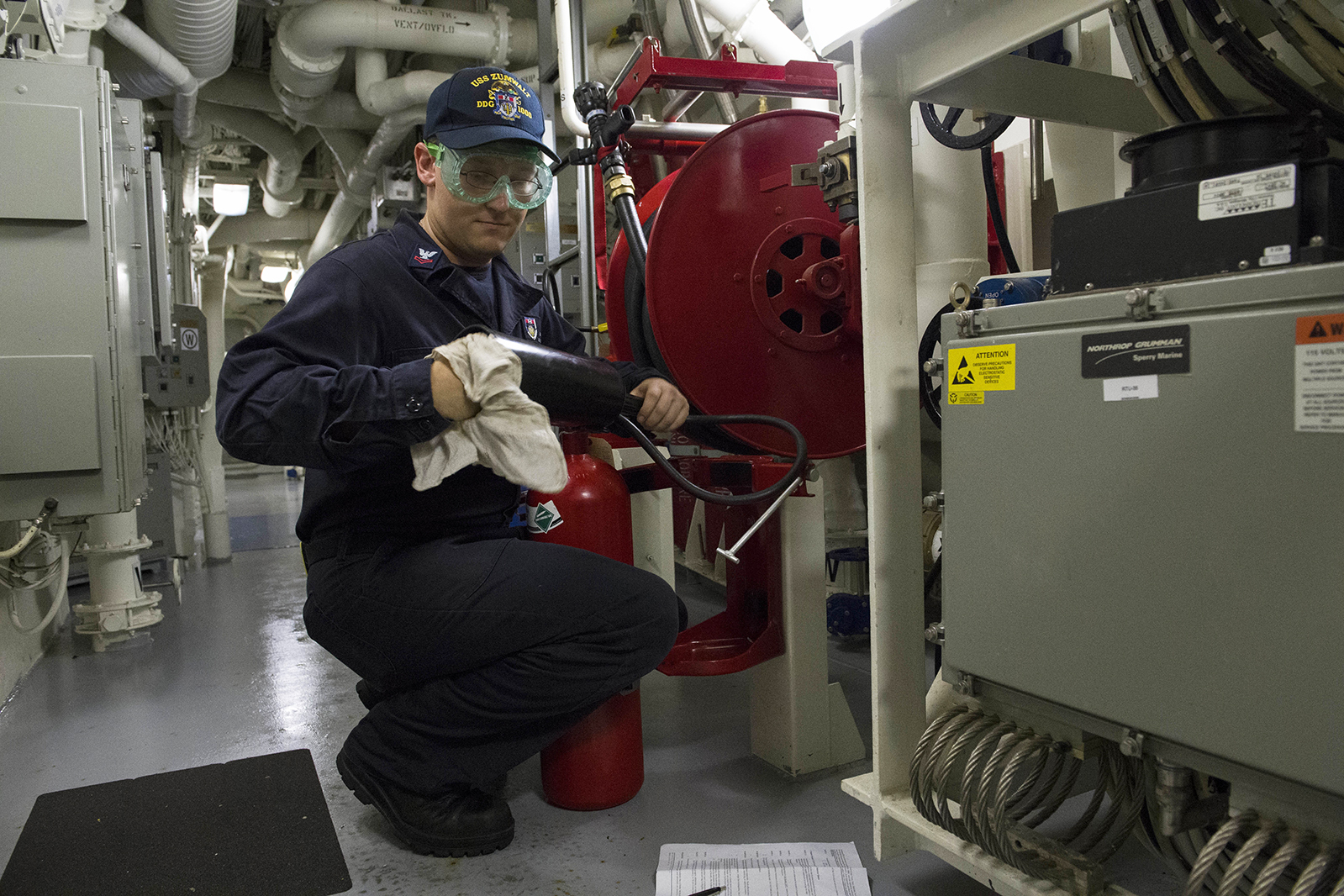
As an epilogue, the fascination with technology has infected more than just the DDG-1000 community. There are a multitude of synchronous AC motors in the fleet happily driving centrifugal pumps. This type of pump will never pump against a shut off head, meaning it will never over pressurize. They sit there happily spinning at constant speed, providing the desired pressure. But now, we are installing IGBT based drive units on all these motors at great cost, both in terms of their installation and their life cycle costs. Not because we need to but just because we can.
Littoral Combat Ship and the Navy’s need for an actual frigate
The LCS is not a frigate. In fact, I am not sure what it is. It seems to me to be a ship looking for a mission. Or perhaps only a means to keep mid size shipyards at opposite ends of the nation in business. The fact that the Navy can’t decide whether they want a one hulled or multi-hulled ship design confirms the latter, as well as recent statements from the Chief of Naval Operations (CNO) to Congress regarding the minimum number of future hulls needed to keep the doors open at Marinette and Austal—the two shipyards that build Littoral Combat Ships.
I was just a high pressure steam engineer, but I read a lot of history, and I do not recall very many times when we needed a special ship just to fight in a littoral somewhere. If we have to defend our own littoral, we have already lost that battle and likely the war. If we need to conduct combat operations in other littorals, then I would suggest that standoff weapons like the Tomahawk or a carrier alpha strike would be more appropriate, at least until the floating enemy is eliminated, and then we can send in the Marines.
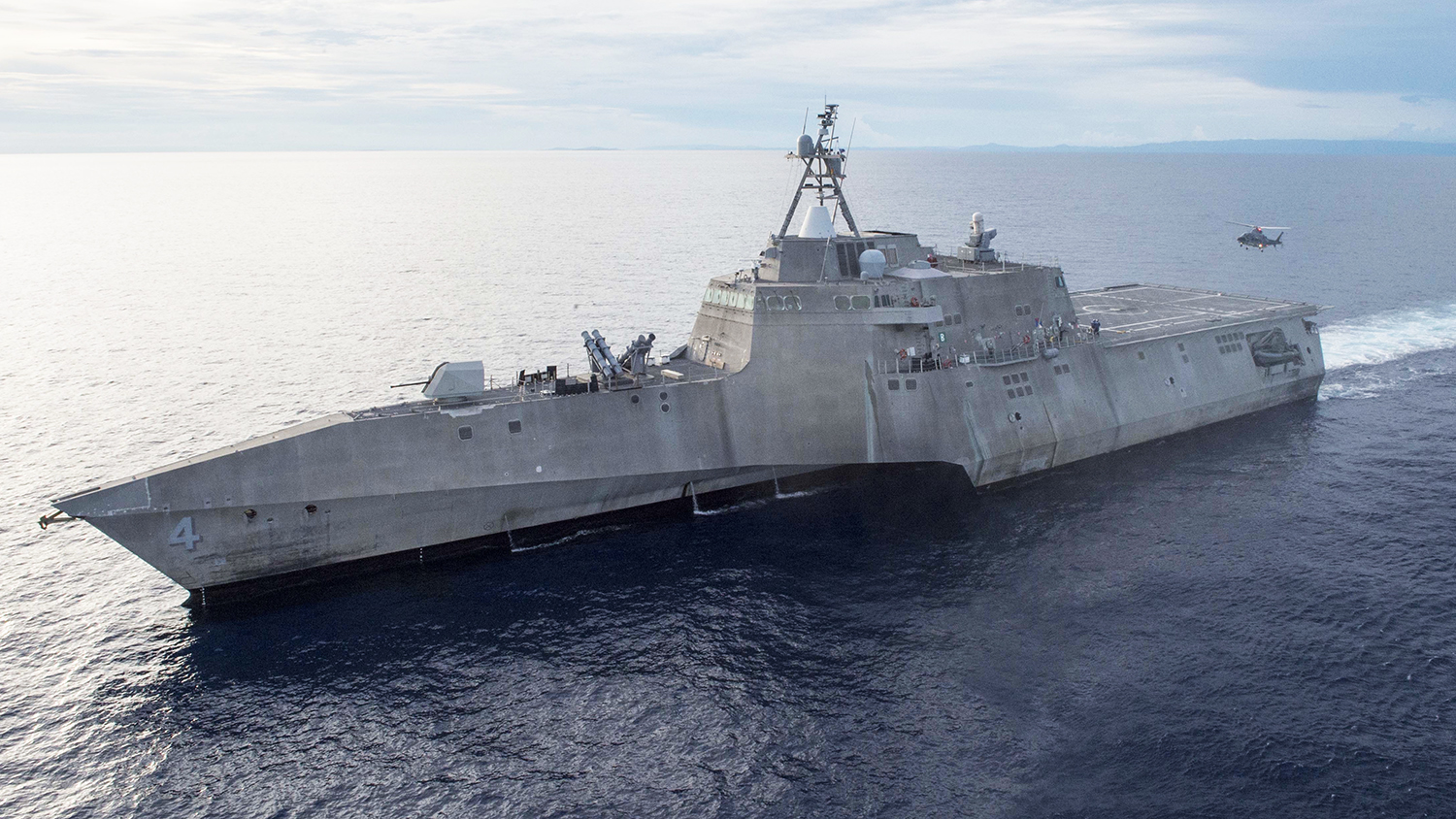
Years ago, I was at a Fisher Maritime conference where I had a chance to hear the Dutch equivalent of the CNO speak. In part of his address, he spoke of the LCS, which was still in the planning stages at the time. While he allowed that the idea of having a ship made super versatile by multiple mission modules was attractive from the tactical standpoint, it would take a very big nation, with a very big budget, to afford to have all but one of those modules, and the trained people to operate and maintain them, sitting on the beach while one was deployed on its specific mission.
By the time I retired for the final time, I do not think any of those modules, of any kind, had been successfully deployed.
What is a frigate? What is its role? To me, the frigate is intended to be an escort for a Carrier Battle Group, or Amphibious Ready Group, or a replenishment ship. They can rarely operate alone. Even with a good anti-air warfare radar and missile system they need cooperative air cover from a cruiser or another frigate. With a better sonar than the “Helen Keller” the Perry class had, they could do anti-submarine warfare, but then again not alone. They are half a destroyer.
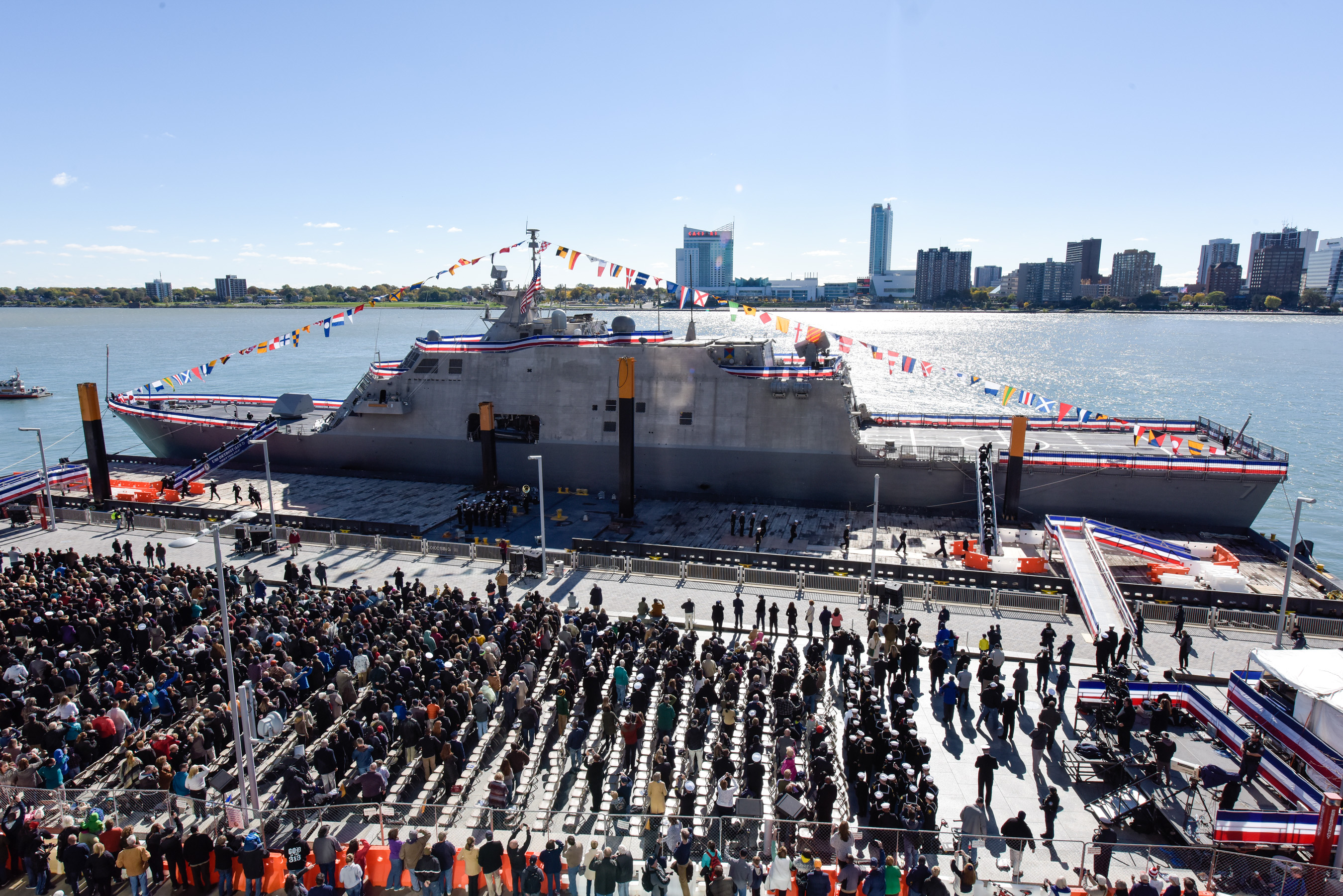
We have a very successful class of destroyers now, with more being built and constant upgrades ongoing on existing hulls. The bones and engines are mature and sound and most improvements are made in the electronics and software realm. One obvious exception being the Auxiliary Propulsion Motor (APS), which has probably completed its trials by now. It seems to me that the programmatic costs of developing a new class of ship are far greater than continuing with the Burke class, a ship that can do all of the things a frigate is supposed to do, as well as use less than half of its installed propulsion plant for economic steaming, or the APS, if it works out.
Building smaller aircraft carriers
The biggest advantage of a carrier battle group is that it can do just about anything you need it to. You want anti-submarine warfare (ASW)? They got the aircraft for that. You want to bomb a shore installation to dust and gravel? They can whistle up an alpha strike. You want to make some rookie pilot from a third world country flying a 20 year old 2nd generation former Soviet fighter wish he had never seen a flight suit? Our pleasure, thank you very much for the opportunity! Some tin pot dictator is rattling his sword? Just the news that a carrier battle ground is leaving port early and heading in that direction is usually enough to quiet things down. Perhaps their greatest value is their potential to do all those things and more.
No one else has them. No one else can conduct continuous flight ops the way we can, and it is going to be a long time before the Chinese can. Big deck carrier aviation and underway replenishment are the two things that set us apart from any Navy, anywhere.
However, they are expensive to build and operate and take forever to hit the fleet. I can see a class of ships, built along the lines of LHD-8—absent the well deck and other assorted landing force systems—powered by a diesel and gas turbine combination. A combination of F-35s, Ospreys and helicopters could be a good tactical mix for specific missions. You would be restricted to VTOL or STOVL aircraft, because it takes a long flight deck to launch and recover the others. Air wings could be tailored to the mission and any major ops may require multiple decks of that size to ensure that large and frequent enough sorties can be maintained. As I review the above, I am flashing back to the “Jeep” carriers of the Second World War. I guess if we went that way, we would have no trouble thinking up names.
Editors note: This ship and concept already exists under the USMC’s “Lightning Carrier” concept.
The USS Fitzgerald mishap
One should wait to draw any conclusions until all of the computer data, logs and voice recordings are analyzed. If the Navy is not forthcoming with that data, then we may begin to suspect that there is something rotten in the Tokyo Wan.
I do have two concerns, based upon what has been reported rather than speculated. The only place in the world with which I am familiar that has more traffic than the area in question are the Straits of Malacca, between Singapore and Sumatra. The difference being that most of the traffic in the Straits of Malacca is, with the exception of small coastal and fishing vessels, going either into or out of the Indian Ocean. On the other hand, traffic leaving or entering the area leading to Yokohama and Tokyo is moving on courses virtually around the compass.
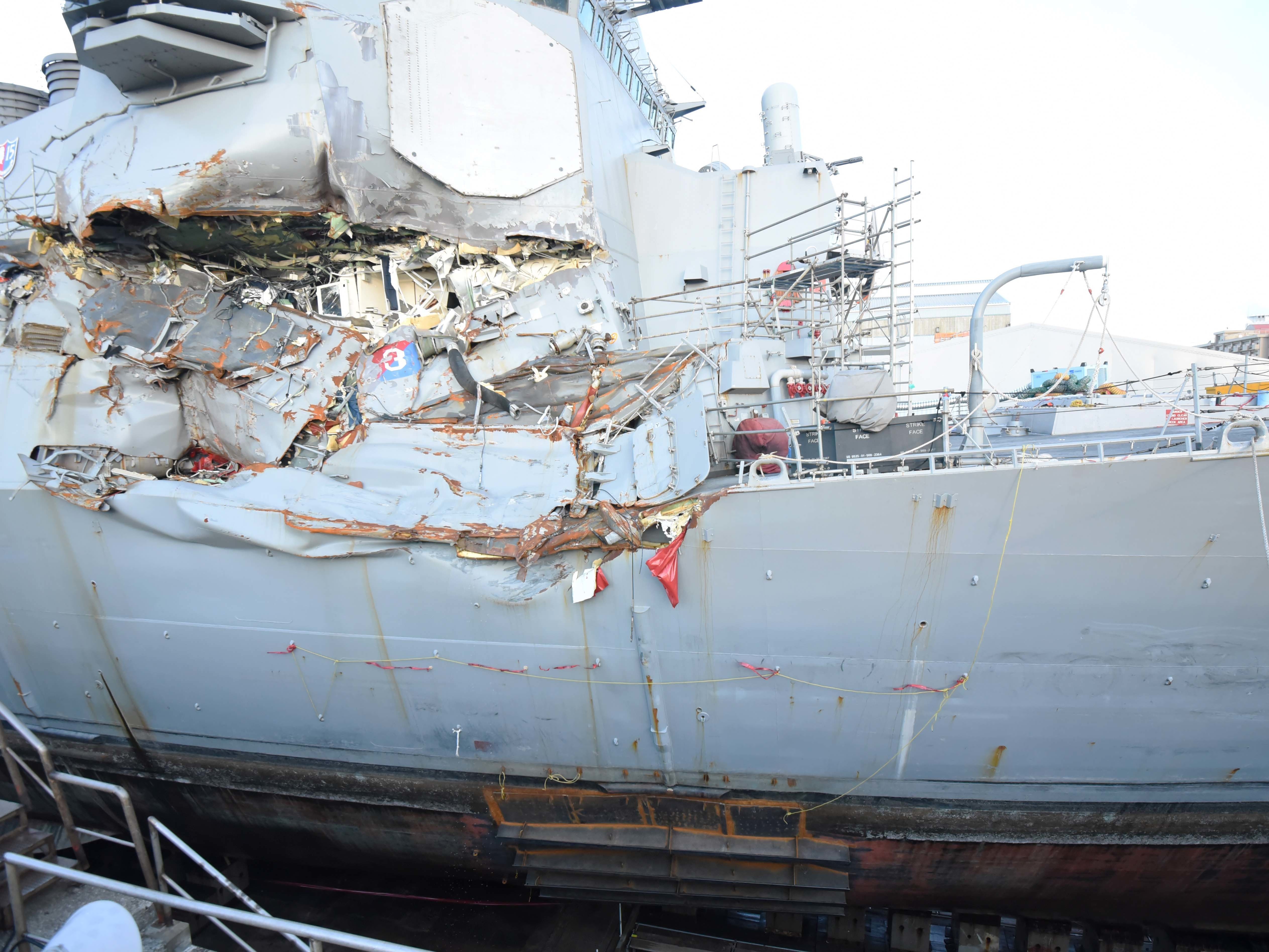
So, my questions are these: Why, with all this traffic, in the middle of the night, was the skipper in the rack? And an even bigger question, what the hell were they doing there in the first place at that time of night? A more forehanded—the greatest virtue of a Naval officer—skipper, regardless of when he was scheduled pier side at Yokosuka, would have cleared the area for safe nighttime steaming, had the navigator plan a course to head for port after sunrise and then hit the rack so as to be rested for the transit through traffic.
And that’s all I have to say about Fitzgerald until we see the tapes.
A huge thanks to LCDR(R) David Taylor for taking so much time to share his thoughts and experiences with us. I think it is safe to say we all have a better appreciation of all the hard work that goes on deep below the decks of US Navy ships after reading this two part series.
Contact the editor: Tyler@thedrive.com
